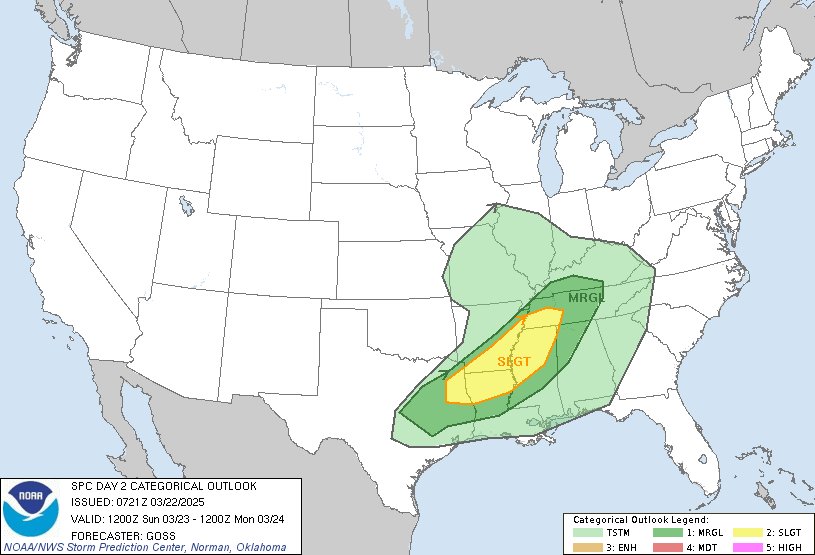|
|
|
0 members (),
265
guests, and
21
robots. |
|
Key:
Admin,
Global Mod,
Mod
|
|
S |
M |
T |
W |
T |
F |
S |
|
|
|
1
|
2
|
3
|
4
|
5
|
|
6
|
7
|
8
|
9
|
10
|
11
|
12
|
|
13
|
14
|
15
|
16
|
17
|
18
|
19
|
|
20
|
21
|
22
|
23
|
24
|
25
|
26
|
|
27
|
28
|
29
|
30
|
|
|
|
|
There are no members with birthdays on this day. |

#759613
Tue 01 Apr 2025 06:03:AM
|
Joined: Feb 2001
Posts: 381,904
Launch Director
|
OP

Launch Director
Joined: Feb 2001
Posts: 381,904 |
SPC Apr 1, 2025 0600 UTC Day 2 Convective OutlookSPC 0600Z Day 2 Outlook 
Day 2 Convective Outlook
NWS Storm Prediction Center Norman OK
0100 AM CDT Tue Apr 01 2025
Valid 021200Z - 031200Z
...THERE IS AN ENHANCED RISK OF SEVERE THUNDERSTORMS FROM THE LOWER
GREAT LAKES TO THE OH/MID MS VALLEY...
...SUMMARY...
Numerous severe storms are likely Wednesday and Wednesday night
across the Lower Great Lakes, Mid Mississippi Valley, and the
ArkLaTex. Severe wind gusts, very large hail, and strong tornadoes
are possible.
...Synopsis...
A broad mid-level trough and powerful 100+ kt jet streak will move
northeastward across the upper Midwest and Great Lakes regions
Wednesday. Strong ascent from the advancing upper trough and primary
shortwave impulse will support a deep surface low moving from the
northern Plains into the western Great Lakes. A warm front will
rapidly lift north through the morning and early afternoon across
parts of eastern IA, MO, IL and IN. 60s F surface dewpoints appear
likely to reach southern lower MI by the afternoon. A cold front
attendant to the deep surface cyclone will sweep eastward, with
widespread strong to severe storms expected to be ongoing
along/ahead of the front at daybreak.
...Upper Midwest and Great Lakes...
The presence of early morning storms and strong low-level warm
advection substantially complicates the forecast convective
evolution across the Great lakes and Midwest. Model guidance varies,
but some solutions show these storms may re-intensify with the
diurnal cycle posing a significant wind/tornado risk, given the very
strong effective shear present. Other guidance suggests this initial
activity could outrun the better buoyancy with eastward extent,
potentially limiting the northward extent of return moisture and
subsequent destabilization. Regardless, very strong synoptic ascent
and low/deep-layer shear will support a threat of damaging winds and
tornadoes if surface-based storms can be sustained into the Great
Lakes and Midwest region during the afternoon and evening. Higher
severe probabilities for damaging winds and possibly tornadoes may
be needed in futures outlooks, as confidence in the warm frontal
position and convective evolution are further resolved.
...Ozarks and the Mid MS Valley...
Farther south, multiple embedded perturbations will overspread parts
of the Midwest and mid MS and lower OH valleys as the trough and jet
shift eastward Wednesday and Wednesday night. While displaced south
of the primary ascent, moderate height falls will take place across
the western half of a very broad warm sector. A few storms may be
ongoing along the slow moving Pacific front/dryline across eastern
OK and western AR/MO early. Re-intensification of this convection is
possible by mid to late morning as the boundary-layer begins to warm
and destabilize. Elongated hodographs, though with somewhat veered
low-level flow, suggest a risk for large hail and a few tornadoes is
likely. Some upscale growth is also possible with a mixed mode and
numerous storm interactions along and near the front.
Additional development appears likely along a per-frontal confluence
axis, or within the broader warm sector across the western Mid MS
Valley and lower OH valley by mid afternoon. Strong, but somewhat
meridonal shear profiles may support a mixed mode of supercells and
clusters as storms develop within a very favorable parameter space
for significant severe weather (STP 3+). Hodographs will remain
large through much of the afternoon and into the evening with ESRH
of 300-400 m2/s2. This suggests any longer-lived supercells will
pose a risk for strong tornadoes, in addition to very large hail and
damaging winds.
...Red River and the ArkLaTex...
Along the southern extent of the dryline/Pacific front, subtle
height falls may support only isolated storm development. Still a
couple storms appear likely by early to mid afternoon across parts
of northeast TX, southern AR and northern LA. Strong mid-level flow,
robust moisture (dewpoints near 70 F), and large hodographs will
likely support supercells with all hazards. These storms should
persist into parts of the mid and lower MS valley overnight with a
continued severe risk.
Later in the evening, a secondary low-level jet surge will begin
across north TX and the Red River vicinity. Warm advection storms
are likely to develop after 06z as the stalling cold front begins to
lift back north into OK/TX as a warm front. Steep mid-level lapse
rates and strong vertical shear will favor elevated
supercells/clusters with an attended risk for large hail and
isolated damaging gusts overnight.
..Lyons.. 04/01/2025
Read morehttps://www.spc.noaa.gov/products/outlook/day2otlk_0600.html
|
|



CMS The Best Conveyancing solicitors conveyancing quotes throughout the UK
For any webhosting enquiries please email webmaster@aus-city.com
|
|
Forums60
Topics723,162
Posts757,778
Members2,958
| |
Most Online4,158
Jun 21st, 2024
|
|
|
|
|
Copyright 1996 - 2024 by David Cottle. Designed by David Bate Jr. All Rights Reserved.
By using this forum, the user agrees not to transfer any data or technical information received under the agreement, to any other entity without the express approval of the AUS-CITY Forum Admins and/or authors of individual posts (Forum Admins and DoD/USSPACECOM for the analysis of satellite tracking data).
Two-line elements (TLE) and all other satellite data presented and distributed via this forum and e-mail lists of AUS-CITY are distributed with permission from DoD/USSTRATCOM.



Reprise Hosting








|

|